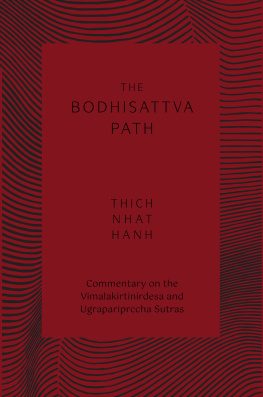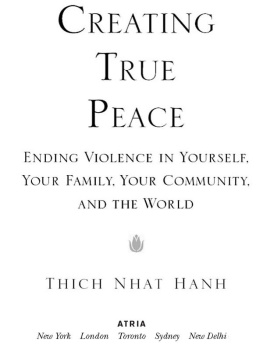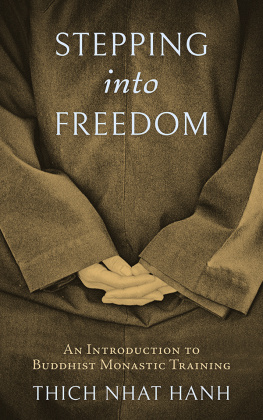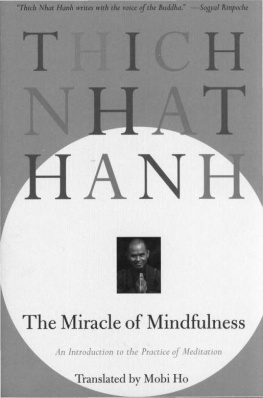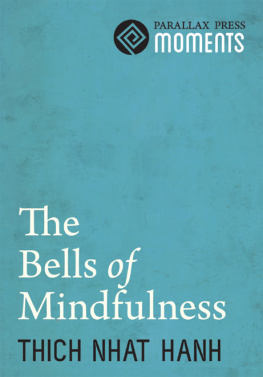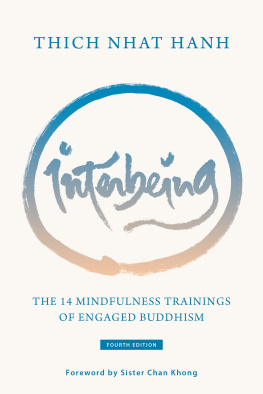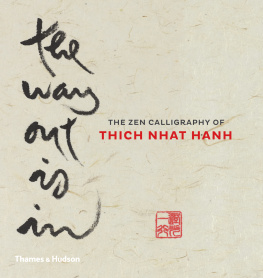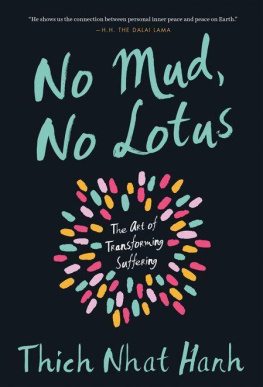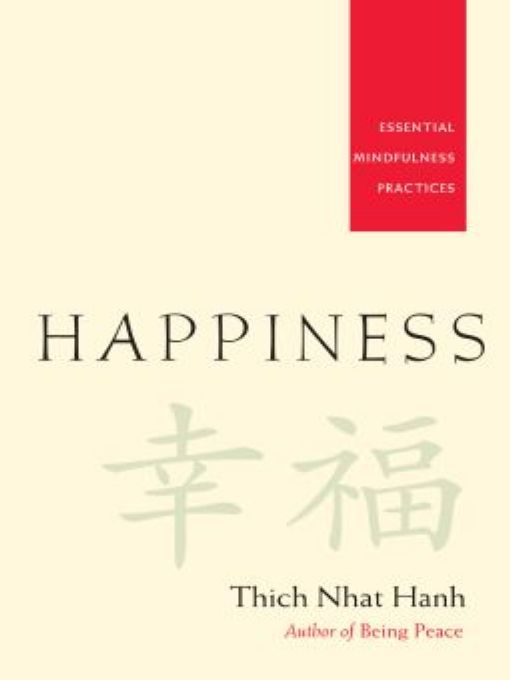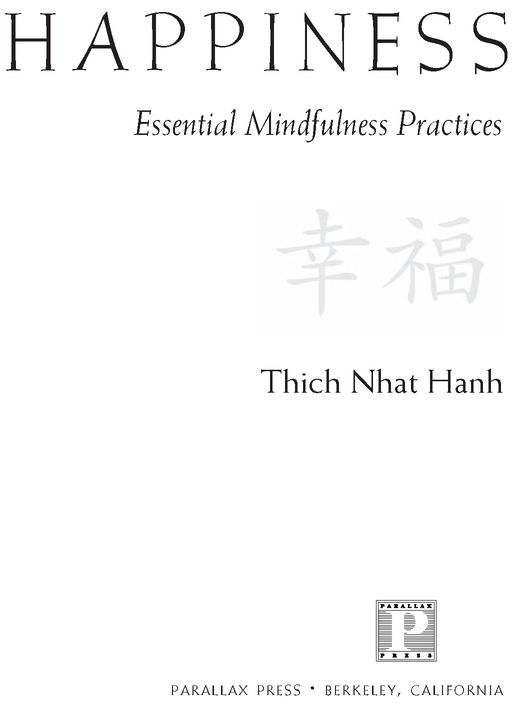Table of Contents
INTRODUCTION
Mindfulness is the energy of being aware and awake to the present. It is the continuous practice of touching life deeply in every moment. Practicing mindfulness does not require that we go anywhere different. We can practice mindfulness in our room or on our way from one place to another. We can do very much the same things we always dowalking, sitting, working, eating, talkingexcept we learn to do them with an awareness of what we are doing.
Imagine youre standing with a group of people, contemplating a beautiful sunrise. But while others drink in the view, you struggle. Youre preoccupied with your projects and worries. You think about the future and the past. Youre not really present to appreciate the experience. So rather than enjoy the sunrise, you let the richness of the moment slip by.
Suppose, instead, you took a different approach. What if, as your mind wanders, you direct your focus to your in-breath and out-breath? As you practice breathing deeply, you bring yourself back to the present. Your body and mind come together as one, allowing you to be fully available to witness, contemplate, and enjoy the scenery. By going home to your breath, you regain the wonder of the sunrise.
We often become so busy that we forget what were doing or who we are. I know many people who say they even forget to breathe. We forget to look at the people we love and to appreciate them until theyre gone. Even when we have some leisure time, we dont know how to get in touch with what is going on inside us. So we turn on the television or pick up the telephone as if we might be able to escape from ourselves.
Awareness of the breath is the essence of mindfulness. According to the Buddha, mindfulness is the source of happiness and joy. The seed of mindfulness is in each of us, but we usually forget to water it. If we know how to take refuge in our breath, in our step, then we can touch our seeds of peace and joy and allow them to manifest for our enjoyment. Instead of taking refuge in an abstract notion of God, Buddha, or Allah, we realize that God can be touched in our breath and our step.
This sounds easy, and everyone can do it, but it takes some training. The practice of stopping is crucial. How do we stop? We stop by means of our in-breath, our out-breath, and our step. That is why our basic practice is mindful breathing and mindful walking. If you master these practices, then you can practice mindful eating, mindful drinking, mindful cooking, mindful driving, and so on, and you are always with peace and happiness.
Our practice is the practice of mindfulnessmindfulness of breathing, walking, eating, dishwashing, and cookingalways dwelling in the here and the now and not allowing ourselves to be pulled away by worries, projects for the future, or regrets about the past.
The practice of mindfulness (Smrti in Sanskrit) leads to concentration (Samadhi), which in turn leads to insight (praja). The insight we gain from mindfulness meditation can liberate us from fear, anxiety, and anger, allowing us to be truly happy. We can practice mindfulness using something as simple as a flower. When I hold a flower in my hand, Im aware of it. My in-breath and out-breath help me maintain my awareness. Rather than becoming overwhelmed by other thoughts, I sustain my enjoyment of the flowers beauty. Concentration itself becomes a source of joy.
If we want to fully enjoy lifes gifts, we must practice mindfulness at every turn, whether were brushing our teeth, cooking our breakfast, or driving to work. Every step and every breath can be an opportunity for joy and happiness. Life is full of suffering. If we dont have enough happiness on reserve, we have no means to take care of our despair. Enjoy your practice with a relaxed and gentle attitude, with an open mind and a receptive heart. Practice for understanding and not for the form or appearance. With mindfulness, we can preserve an inner joy, so that we can better handle the challenges in our lives. We can create a foundation of freedom, peace, and love within ourselves.
DAILY PRACTICES
CONSCIOUS BREATHING
In our daily life, we breathe, but we forget that were breathing. The foundation of all mindfulness practice is to bring our attention to our in-breath and out-breath. This is called mindfulness of breathing, or conscious breathing. Its very simple, but the effect can be very great. In our daily life, although our body is in one place, our mind is often in another. Paying attention to our in-breath and out-breath brings our mind back to our body. And suddenly we are there, fully present in the here and the now.
Conscious breathing is like drinking a glass of cool water. As we breathe in, we really feel the air filling our lungs. We dont need to control our breath. We feel the breath as it actually is. It may be long or short, deep or shallow. In the light of our awareness it will naturally become slower and deeper. Conscious breathing is the key to uniting body and mind and bringing the energy of mindfulness into each moment of our life.
Regardless of our internal weatherour thoughts, emotions, and perceptionsour breathing is always with us like a faithful friend. Whenever we feel carried away, sunk in a deep emotion, or caught in thoughts about the past or the future, we can return to our breathing to collect and anchor our mind.
Practice
While you breathe in and out, feel the flow of air coming in and going out of your nose. At first your breathing may not be relaxed. But after practicing conscious breathing for awhile, you will feel how light and natural, how calm and peaceful your breathing has become. Any time youre walking, gardening, typing, or doing anything at all, you can return to this peaceful source of life.
You can say to yourself:
Breathing in, I know Im breathing in.
Breathing out, I know Im breathing out.
After a few breaths, you may want to shorten this to: In, Out. If you follow your in-breath and out-breath all the way through, your mind is no longer thinking. Now your mind has a chance to rest. In our daily life we think too much. Giving our mind a chance to stop thinking is wonderful.
Breathing in, I know Im breathing in isnt a thought. Its a simple awareness that something is happening, that you are breathing in and out. When you breathe in and bring your attention to your in-breath, you bring your mind back to a reunion with your body. Just one in-breath can help the mind come back to the body. When body and mind come together, you can be truly in the present moment.
Breathing in, I know Im breathing in is another way of saying Breathing in, I feel alive. Life is in you and life is around youlife with all its wonders: the sunshine, the blue sky, the autumn leaves. Its very important to go home to the present moment to get in touch with the healing, refreshing, and nourishing elements of life inside and around you. A light smile can relax all the muscles of your face.
Breathing in, I recognize the blue Sky.
Breathing out, I Smile to the blue Sky.
Breathing in, I am aware of the beautiful autumn leaves.


